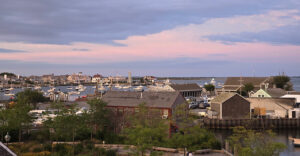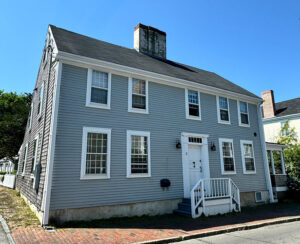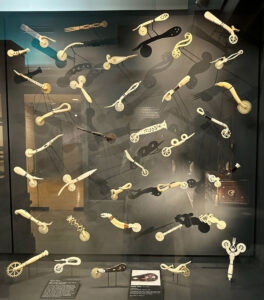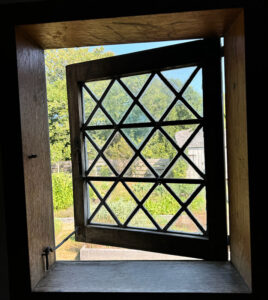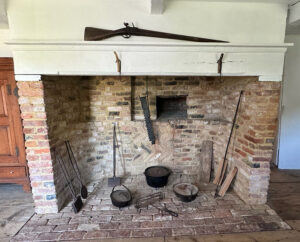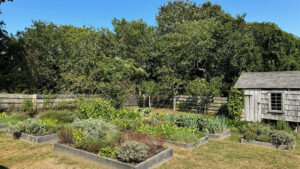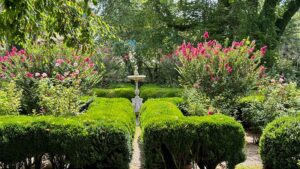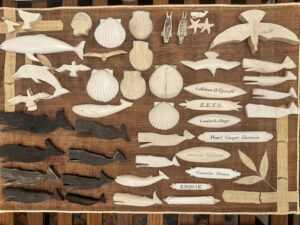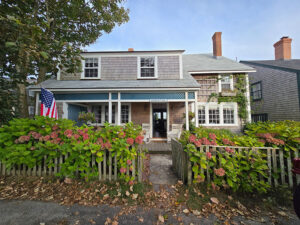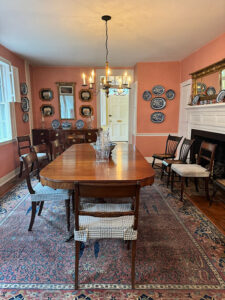Swept Away: Discovering Nantucket’s Culture of Island Collecting
SOJOURN
September 4–8, 2024
Go coastal with the Trust as we expand our appreciation for maritime studies, historic preservation, and island collecting during this Sojourn in Nantucket, MA. A prized New England summertime haven, this tiny island’s big personality ranges from Quaker roots and the whaling industry to grand Greek Revival edifices and the conspicuous consumption of exotic goods. Alongside Trust Governor and Winterthur Professor Emeritus Brock Jobe, we explore the island’s way of life, artistic legacies, distinctive culture, and the lore of Moby Dick. Surrounded by sea and sky, this September excursion showcases Nantucket’s dreamy views and deep traditions of trade, travel, and tourism.
REGISTRATION NOW CLOSED
ITINERARY
Wednesday, September 4
Our Sojourn begins at the Faraway Nantucket, accommodations that epitomize island elegance within 200-year-old classic New England architecture at the center of town. Steps away is the Nantucket Historical Association’s celebrated Whaling Museum, where Chief Curator Michael Harrison sets the stage with an opening lecture delving into Nantucket’s unique material history. Tours of the museum’s collection follow, featuring one of the world’s most important collections of scrimshaw, along with lightship baskets, locally made furniture, and whimsical whirligigs. A special viewing of illustrator Tony Sarg’s pictorial maps and manuscripts rounds out our visit before returning to the Faraway for handcrafted cocktails and a special dinner in the hotel’s nautical-chic restaurant, Sister Ship.
Included: R, D
Thursday, September 5
We spend our day enjoying the historic 18th-century homes of Nantucket. Our first stop is the Jethro Coffin House, nicknamed “The Oldest House.” Built as a wedding gift in 1686, it is believed to be the oldest residence on the island still standing on its original site. The house was constructed during a pivotal period for Nantucket when the English population was establishing their presence, and the Wampanoag people still outnumbered them significantly. The house belonged to Jethro Coffin, a prominent early settler and shipbuilder, and is a reminder of Nantucket’s colonial past and the island’s evolution from a small settlement to a thriving whaling center.
Equally steeped in history, the First Congregational Church stands as one of Nantucket’s oldest religious institutions. Its journey began even before a formal building existed, with the congregation establishing its first pastor by 1725. Remarkably, the oldest standing structure associated with the church, the Old North Vestry, dates back to the same year and continues to serve the community today. The present church today was born from the vision of Boston housewright Samuel Waldron and represents an elegant fusion of Greek and Gothic Revival styles. Its interior, completed in 1852, boasts captivating trompe l’oeil paintings by E.H. Whitaker of Boston, adding a touch of architectural illusion. While the original steeple was removed in 1849 due to structural concerns, it was meticulously reconstructed in 1968 based on historic drawings by Philip Graves of Ames & Graves, ensuring the church’s continued presence on the island’s skyline.
After an alfresco lunch in a beautiful garden, we continue to two private houses built by the storied Starbuck whaling family. Possessing the understated simplicity preferred by the Quakers, the Thomas Starbuck homestead was built in 1756 and relocated from Sherburne, an older settlement west of Nantucket, to its current site in 1790 and is believed to be the first house on Milk Street. The 1740 Nathaniel Starbuck House is located next door and both houses now belong to Trust friend Hampton Lynch.
Our day concludes with refreshments at the kind invitation of Niles D. Parker, the Gosnell Executive Director of the Nantucket Historical Association. His home, the Nathaniel Macy House was relocated from Sherburne and then moved to its current location sometime prior to 1745. The simple saltbox-style domicile is a typical example of the time it was built. Concluding our day at the Faraway Hotel permits convenient access to downtown eateries for an independent dinner.
Included: B, L, R
Friday, September 6
We venture eastward to explore island landscapes and the town of Siasconset, or ’Sconset, as it is locally known. Lush gardens fill our morning before a seasonal lunch at local neighborhood darling, The Chanticleer. After fortification, we begin an exhilarating tour of the Windswept Cranberry Bog. A man-made cranberry paradise since the early 1900s, the site found new life in 1980 as a Foundation preserve. Cranberries, a cornerstone of the island’s economy since 1857, are still cultivated at the Foundation’s Milestone Bog, and Windswept is now a wetland restoration project with the Massachusetts Division of Ecological Restoration.
Afterwards, we embark on a walking tour of Historic ’Sconset Village, beginning at the Bluff Walk, where we will take in expansive views of the ocean. The Siasconset Casino opened to a tremendously enthusiastic audience in 1900 and has hosted social, dramatic, and sporting events in its dedicated indoor-outdoor community space ever since. The original simple design received a later update when architect Frederick Hill, of McKim, Mead & White, incorporated intricate lattice work designs over the walls and ceilings, echoing features of the firm’s famed Newport Casino. We then proceed to ’Sconset Chapel, which was established in 1883 and remains today a pillar of the community. This Gothic Revival church, though weathered and missing some ornamentation, maintains its grandeur. The corner tower with its pointed peak, the high gabled roof, and the graceful arches in the windows all speak to its original style. Historical additions include a transept built in 1887 and unique decorative metal sheets adorning the interior walls and ceilings from 1909. Most noticeably, four buttresses were added on each side of the nave in 1942, reinforcing the structure. Next on our journey is a private residence on Nonantum Avenue. Steeped in ’Sconset’s whaling and fishing past as one of the original whaling cottages of the early 19th century, it has been passed down through generations which has resulted in its exemplary condition.
Finally, we reflect on our day with a convivial dinner at the ’Sconset home of Trust members Martha Dippell and Danny Korengold.
Included: B, L, D
Saturday, September 7
Steps away from our hotel is the Nantucket Atheneum, which began as a private library in the 1820s, formed from two social libraries. Charles G. Coffin was a co-founder of the Atheneum; he and his brother were successful in the whaling industry but always held a lifelong interest in education and incorporated lending libraries in each of their ships. After a fire in 1846 destroyed the original building and over 1,200 titles, it rose again on the same spot and became a free public library in 1900. Like the original structure, the new building was designed in a Greek Revival style and was described as “…Perhaps the most monumental building on the island.”
Our morning continues to Brant Point where collector, lawyer, and patron of the arts Max N. Berry hosts us at his magnificent home overlooking the island’s principal harbor. Mr. Berry’s whimsical assemblage of American scrimshaw, Chinese Export porcelain and paintings, toys and mechanical banks, as well Nantucket baskets are sure to delight. Afterward, independent time on downtown’s cobblestone streets permits us an opportunity to explore the island’s regional cuisine and charming local shops where we may even find a lightship basket to call our own!
William Hadwen, a wealthy businessman and philanthropist, built a grand Greek Revival mansion in 1845 across from the three houses built for his wife’s brothers. With its imposing façade and elegant details, the Hadwen House stood out from the typical Nantucket architecture. The house boasts grand entertaining spaces and luxurious accommodations, reflecting the lifestyle of the island’s elite during the whaling era’s peak. Today, the Hadwen House is a museum, offering a glimpse into the opulent lives of Nantucket’s wealthy during this prosperous time. Our afternoon continues with two private house visits. Trust members Janet and Keith Lindgren kindly welcome us to their 1792 Quaker home.
We conclude our tour with a visit to a high-style whale oil merchants’ home which stands out as an early and exceptional example of Greek Revival design on the island. This privately-owned historic residence boasts meticulously preserved details throughout its three stories: a grand entry porch welcomes visitors into an elegant foyer, where a beautiful staircase with original woodwork leads to the living areas. The double parlor features two fireplaces, hinting at the home’s grandeur. Bringing our island journey to a celebratory close, our tour concludes with a special closing dinner.
Included: B, D
Sunday, September 8
Guests depart independently for Nantucket Memorial Airport or the wharf for ferry transport to Hyannis.
Included: B
TERMS AND CONDITIONS
Registration fee: $4,250 per person based on double occupancy, which includes hotel accommodations, plus all lectures, tours, breakfasts (B), lunches (L), receptions (R), dinners (D), and transportation referenced above. Participants may elect to make an additional donation to the Trust’s Emerging Scholars Program through registration.
Single supplement: The single supplement is $850.
Membership: All participants must be members of the Decorative Arts Trust. Click here to see membership levels and benefits.
Cancellations and refunds: All cancellations received by June 7, 2024, are subject to a full refund less a $100 administrative fee per person. Participants canceling between June 8 and August 9, 2024, will receive a 50% refund. Refunds will not be made after August 9, 2024.
Itinerary: The schedule, sites, and events outlined in this itinerary are subject to change as necessary.
Participation: The program is limited to a maximum of 25 participants and requires a minimum of 15. We will organize and maintain a waiting list on the basis of the time registrations are received. The Trust’s itineraries are planned with care and attention to detail to ensure a memorable and rewarding experience for all participants. This itinerary includes standing for long periods of time, walking on uneven surfaces, and ascending and descending stairs without handrails. Please consider if this program is suited for your health, physical condition, and individual circumstances. Participants should be prepared to take COVID tests and to wear masks when requested.

